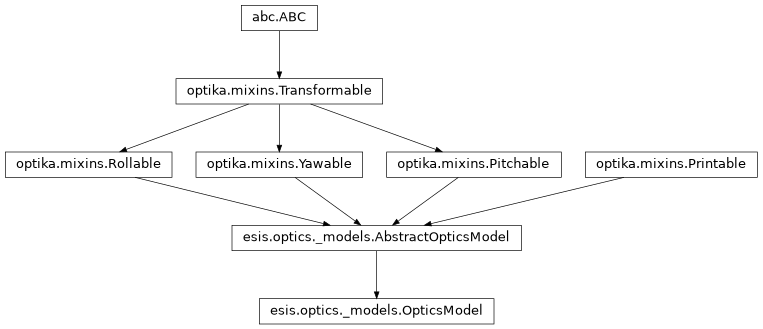OpticsModel#
- class esis.optics.OpticsModel(name: 'str' = 'ESIS', front_aperture: 'None | esis.optics.FrontAperture' = None, central_obscuration: 'None | esis.optics.CentralObscuration' = None, primary_mirror: 'None | esis.optics.PrimaryMirror' = None, field_stop: 'None | esis.optics.FieldStop' = None, grating: 'None | esis.optics.Grating' = None, filter: 'None | esis.optics.Filter' = None, detector: 'None | esis.optics.Detector' = None, grid_input_normalized: 'None | optika.vectors.ObjectVectorArray' = None, pitch: 'u.Quantity | na.AbstractScalar' = <Quantity 0. deg>, yaw: 'u.Quantity | na.AbstractScalar' = <Quantity 0. deg>, roll: 'u.Quantity | na.AbstractScalar' = <Quantity 0. deg>, requirements: 'None | esis.optics.Requirements' = None)#
Bases:
AbstractOpticsModelAttributes
The angle between the grating normal vector and the exit arm, in the plane perpendicular to the rulings.
Resolve this optics model into an instance of
optika.systems.SequentialSystem.the coordinate transformation between the global coordinate system and this object's local coordinate system
the maximum wavelength permitted through the system
the minimum wavelength permitted through the system
Methods
__init__([name, front_aperture, ...])to_string([prefix])Public-facing version of the
__repr__method that allows for defining a prefix string, which can be used to calculate how much whitespace to add to the beginning of each line of the result.Inheritance Diagram

- Parameters:
name (str)
front_aperture (None | FrontAperture)
central_obscuration (None | CentralObscuration)
primary_mirror (None | PrimaryMirror)
field_stop (None | FieldStop)
grating (None | Grating)
filter (None | Filter)
detector (None | Detector)
grid_input_normalized (None | ObjectVectorArray)
pitch (Quantity | AbstractScalar)
yaw (Quantity | AbstractScalar)
roll (Quantity | AbstractScalar)
requirements (None | Requirements)
- to_string(prefix=None)#
Public-facing version of the
__repr__method that allows for defining a prefix string, which can be used to calculate how much whitespace to add to the beginning of each line of the result.
- property angle_grating_input: AbstractScalar#
- property angle_grating_output: AbstractScalar#
The angle between the grating normal vector and the exit arm, in the plane perpendicular to the rulings.
This is an analogue to the diffracted angle in the diffraction grating equation.
- central_obscuration: None | CentralObscuration = None#
- front_aperture: None | FrontAperture = None#
- grid_input_normalized: None | ObjectVectorArray = None#
- pitch: Quantity | AbstractScalar = <Quantity 0. deg>#
- primary_mirror: None | PrimaryMirror = None#
- requirements: None | Requirements = None#
- roll: Quantity | AbstractScalar = <Quantity 0. deg>#
- property system: SequentialSystem#
Resolve this optics model into an instance of
optika.systems.SequentialSystem.This is a cached property that is only computed once.
- property transformation: AbstractTransformation#
the coordinate transformation between the global coordinate system and this object’s local coordinate system
- property wavelength_max: Quantity | AbstractScalar#
the maximum wavelength permitted through the system
- property wavelength_min: Quantity | AbstractScalar#
the minimum wavelength permitted through the system
- yaw: Quantity | AbstractScalar = <Quantity 0. deg>#

